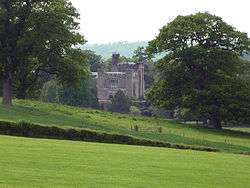Thurland Castle
| Thurland Castle | |
|---|---|
|
Thurland Castle, looking west from the A6 | |
| Location | Between Cantsfield and Tunstall, Lancashire, England |
| Coordinates | 54°09′07″N 2°35′52″W / 54.1520°N 2.5978°WCoordinates: 54°09′07″N 2°35′52″W / 54.1520°N 2.5978°W |
| OS grid reference | SD 611 731 |
| Founded | 14th century |
| Rebuilt | 1879–85 |
| Architect | Paley and Austin |
| Architectural style(s) |
Elizabethan Revival and Gothic Revival |
Listed Building – Grade II* | |
| Designated | 4 October 1967 |
| Reference no. | 1164439 |
 Location in the City of Lancaster district | |
Thurland Castle is a country house in Lancashire, England which has been converted into apartments. Surrounded by a moat, and located in parkland, it was originally a defensive structure, one of a number of castles in the Lune Valley. It is recorded in the National Heritage List for England as a designated Grade II* listed building.[1] Siuated between the villages of Cantsfield and Tunstall the castle stands on a low mound on a flat plain, with the River Greta on the south side and the Cant beck to the north. A deep circular moat surrounds it.[2]
History

The earliest existing fabric dates from the 14th century,[1] and in 1402 Sir Thomas Tunstall was given a licence to crenellate the building.[3] Following Sir Thomas' death in 1441, the castle passed on to his son Thomas, and then later to his brother Brian, a hero of the Battle of Flodden in 1513, who was dubbed the "Stainless Knight" by the king and immortalised in the poem Marmion - A Tale of Flodden Field by Sir Walter Scott. Bryan's son Marmaduke was High Sheriff of Lancashire for 1544. After two or three further generations of Tunstall's the castle was sold to John Girlington in 1605, and passed to his grandson, Sir John Girlington, a Royalist major-general during the Civil War. The castle was badly damaged by Parliamentarian forces during a siege in 1643, following which it was described as being "ruinous".[1] Sir John's son, also John, was High Sheriff of Lancashire for 1663.[4]
Work was done on the building to convert it to a country house in 1810 by Jeffry Wyattville, and in 1826–29 by George Webster,[3] but in 1876 it was gutted by fire.[5] The owner, Mr North North, commissioned the Lancaster architects Paley and Austin to rebuild it, and what is now present is mainly their work.[1][3] Work began in 1879, over 100 men were employed, and it was not completed until 1885.[5] The house and stables have since been converted into several luxury apartments.[3]
Architecture
The building is constructed in sandstone rubble, with slate roofs. It consists mainly of two ranges on the north and west sides of a courtyard. Its architectural style is a mixture of Elizabethan Revival and Gothic Revival.[1] It is approached by an arched bridge crossing the moat.[3] Its windows are either mullioned or mullioned and transomed, and there are two towers, one of which has two storeys, the other three. Many of the parapets are embattled.[1] Around the building are terraces with bastions.[3]
See also
- Grade II* listed buildings in Lancashire
- Listed buildings in Cantsfield
- List of non-ecclesiastical works by Paley and Austin
References
- 1 2 3 4 5 6 Historic England, "Thurland Castle, Cantsfield (1164439)", National Heritage List for England, retrieved 18 November 2012
- ↑ Leslie Irving Gibson (1977). Lancashire Castles and Towers. Clapham, North Yorkshire: Dalesman Books. p. 45.
- 1 2 3 4 5 6 Hartwell, Clare; Pevsner, Nikolaus (2009) [1969], Lancashire: North, The Buildings of England, New Haven and London: Yale University Press, p. 673, ISBN 978-0-300-12667-9
- ↑ Scogland, Thesta (1976). The Garlington Family. Gateway Press.
- 1 2 Brandwood, Geoff; Austin, Tim; Hughes, John; Price, James (2012), The Architecture of Sharpe, Paley and Austin, Swindon: English Heritage, pp. 131, 231, ISBN 978-1-84802-049-8
